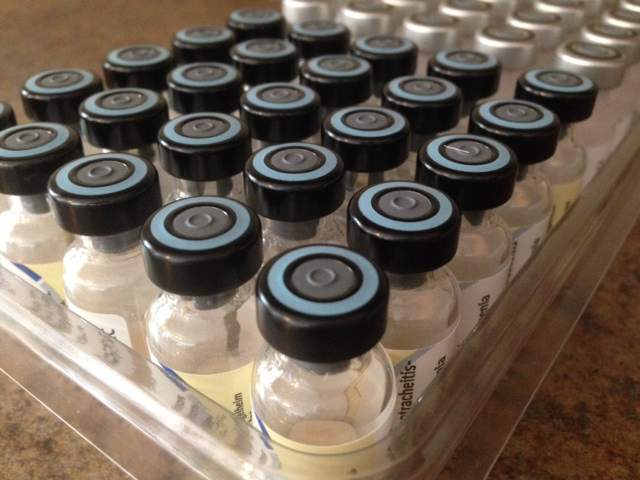The most common feline vaccines are 3 or 4-way combination vaccines that cover the prominent feline respiratory diseases. These being rhinotracheitis(herpes), calicivirus, chlamydia and panleukopenia.
There are two types of vaccines, killed and modified-live. A killed vaccine is a vaccine whose pathogens, or viruses, have been killed via heat or with chemicals. These killed pathogens are combined with an adjuvant (a chemical or cell of certain killed bacteria), which irritates the cat’s system enough to cause an immune response to the killed pathogens. A modified-live vaccine contains viruses that have been altered in a manner that they are unable to cause the disease.
There are pros and cons to each type of vaccine. Many people feel that a killed vaccine is a safer vaccine because there is no chance of the individual contracting a disease from the vaccine. Vets recommend using a killed vaccine on individuals that are known to have a compromised immune system. However, there is evidence that the adjuvant used in killed vaccines is causing cancer at the injection site in a small percentage of individuals. Furthermore, killed vaccines do not command as strong of an immune response as the modified-live vaccines and therefore require more frequent booster vaccinations. The modified-live vaccines are proven to provide a higher quality, longer lasting immune response. However, there is a slight risk of individuals with compromised immune systems contracting a disease.
So what is the right choice? Many Savannah breeders believe strongly that a killed vaccine is the correct answer. I have heard rumors for years that “someone knew someone” that had a cat contract a disease from a modified-live vaccine. I’ve yet to come across one of these individuals myself. We have used both modified-live and killed vaccines over the years and cannot quantitatively say that one is better, or more effective, than the other.
A couple of years ago one of the few manufacturers of a killed 4-way feline vaccine changed the vaccine by adding an additional strain of the calicivirus. It was at this time that I made several calls to vet contacts to inquire about this change. The responses were unanimous that because there are so many strains of the calicivirus, adding one more strain to a vaccine didn’t make it more effective as far as they were concerned, but it did make it considerably more expensive.
I don’t believe there is a right or a wrong choice. I do believe that many breeders cause an unnecessary hysteria about modified-live vaccines. I receive calls from new Savannah owners on a regular basis that they can’t find a vet in their area that carries the killed vaccine and their breeder said that they had to use a killed vaccine. Many vets do not carry killed vaccinations because they have more faith in the modified-live version. My recommendation would be to stay consistent. If a kitten was given one or two vaccines of a certain type, follow through with the same vaccine type for the remainder of its kitten vaccinations. If you are unable to find that type of vaccine in your area, then use what is available, but make sure to give two doses at 2-3 weeks apart to ensure a proper immune response is achieved.



